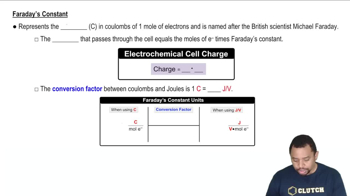Here are the essential concepts you must grasp in order to answer the question correctly.
Electrolysis
Electrolysis is a chemical process that uses electrical energy to drive a non-spontaneous reaction. In this context, it involves the decomposition of molten magnesium chloride (MgCl2) into magnesium and chlorine gas when an electric current is passed through it. The amount of substance produced during electrolysis can be calculated using Faraday's laws, which relate the quantity of electricity used to the amount of substance transformed.
Recommended video:
Faraday's Laws of Electrolysis
Faraday's laws of electrolysis state that the amount of substance produced at an electrode during electrolysis is directly proportional to the quantity of electric charge passed through the electrolyte. The first law quantifies this relationship, while the second law relates the mass of the substance produced to its molar mass and the number of electrons transferred. These principles are essential for calculating the amount of magnesium produced from a given current over time.
Recommended video:
Faraday's Constant in Electrochemistry
Stoichiometry of Gaseous Products
Stoichiometry involves the calculation of reactants and products in chemical reactions. In this case, it is important to understand the stoichiometric relationships between magnesium and chlorine gas produced during the electrolysis of MgCl2. At standard temperature and pressure (STP), one mole of any gas occupies 22.4 liters, allowing for the conversion of moles of chlorine gas produced into liters, which is crucial for determining the volume of Cl2 generated.
Recommended video:
Production of Hydrogen Example
 Verified step by step guidance
Verified step by step guidance

